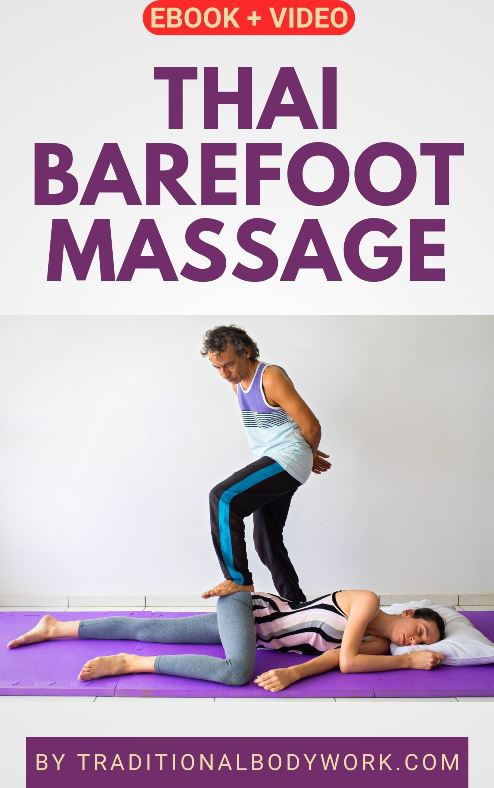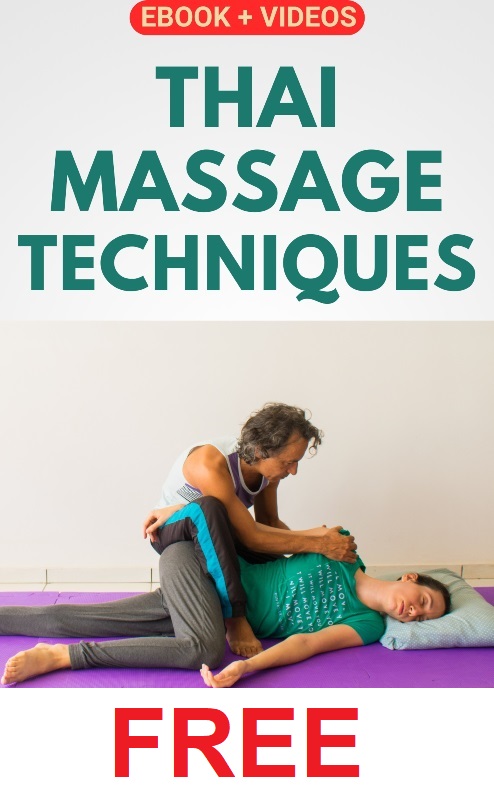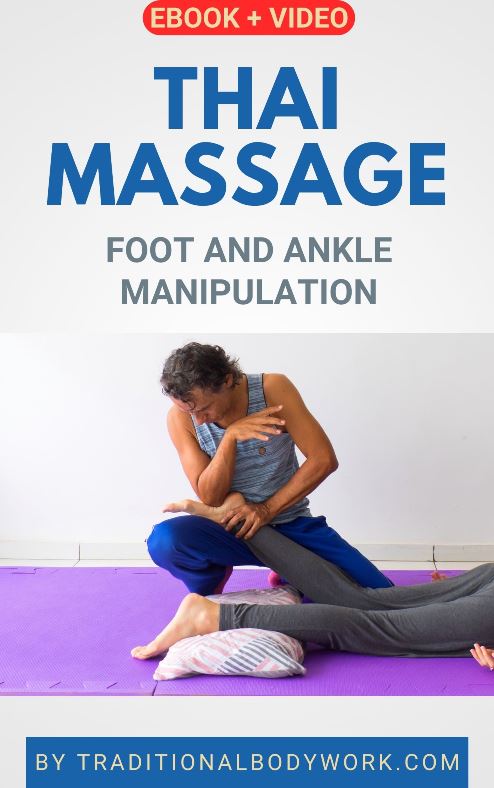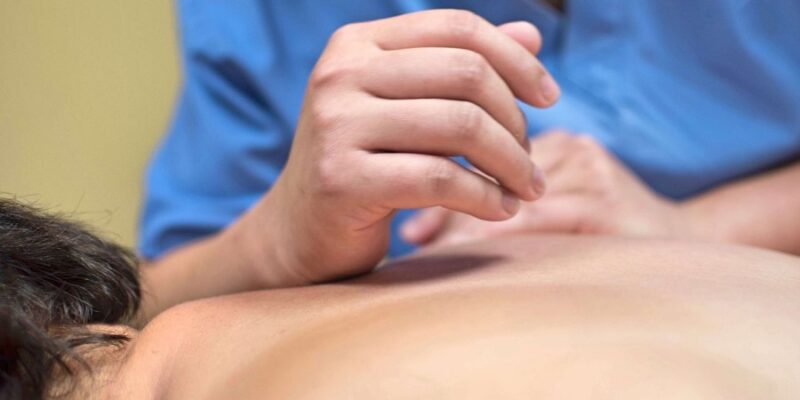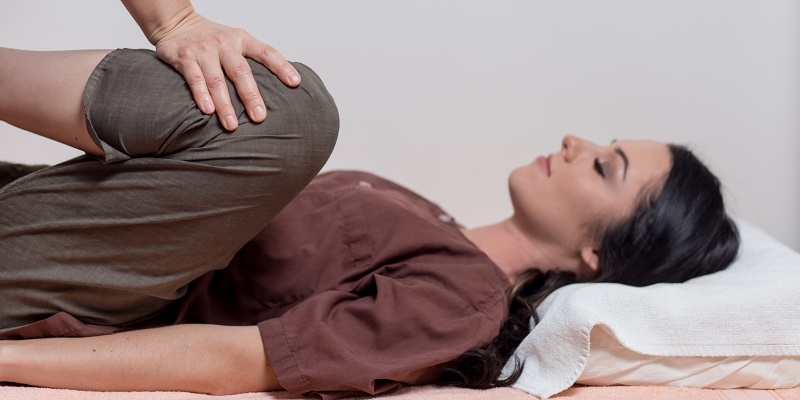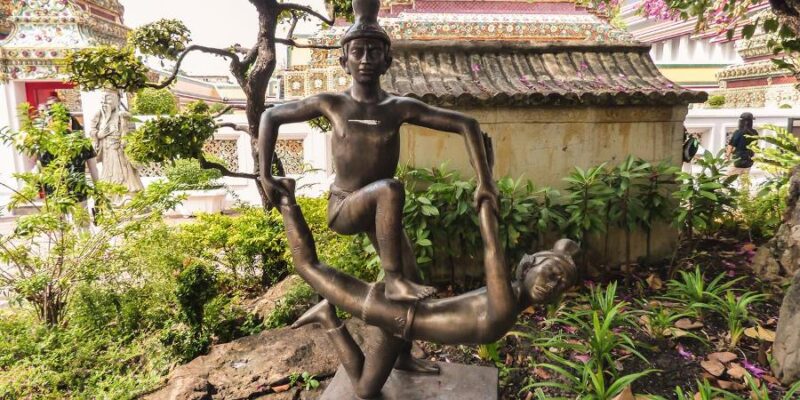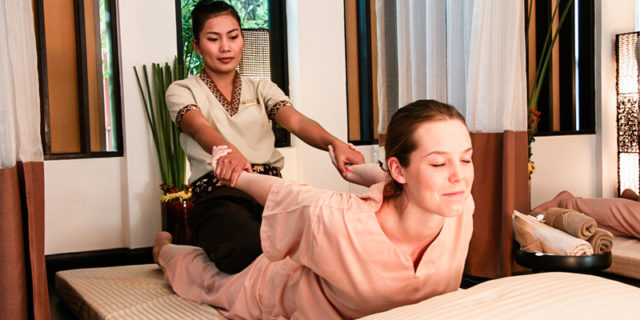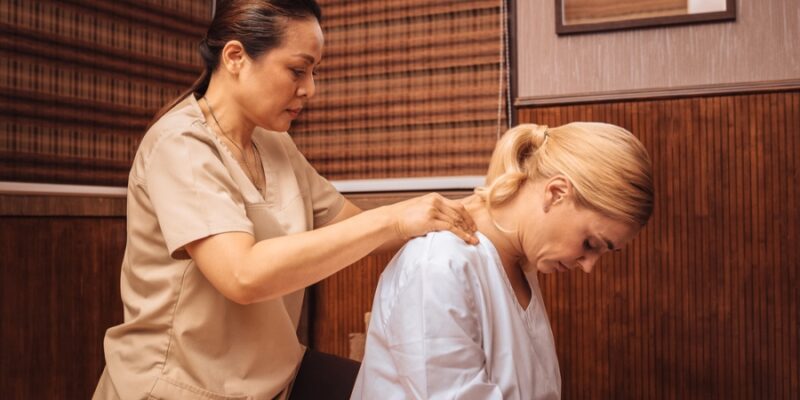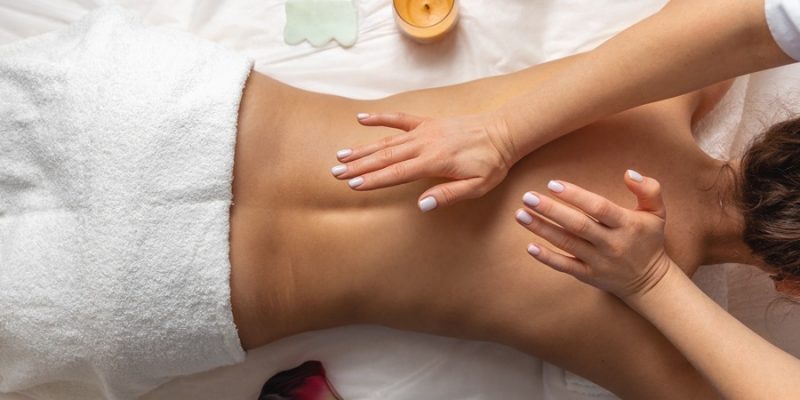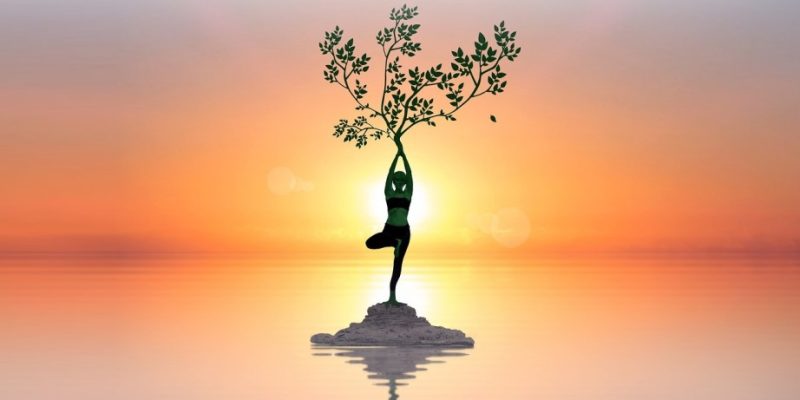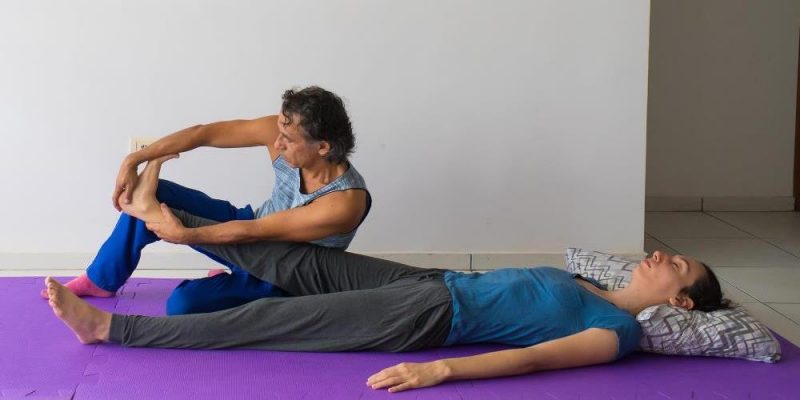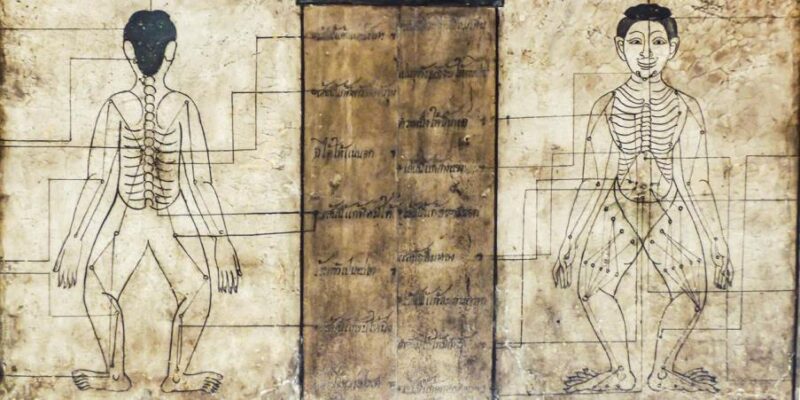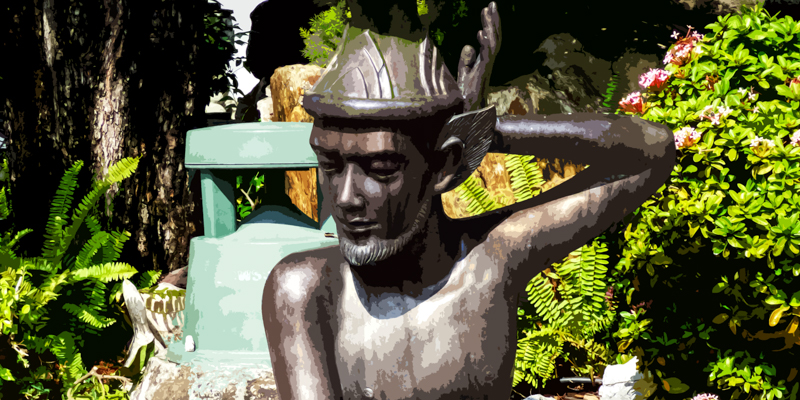
In this article, we’re going to take a look at how we can tackle or ease low back pain problems with Traditional Thai Massage therapy.
To thoroughly understand how to use Thai Massage to resolve or alleviate problems with the lower part of the back, we will first have an in-depth discussion of what low back pain is, the kind of low back pains, and how it’s caused. Subsequently that will be an important part of this article.
Spinal Structure
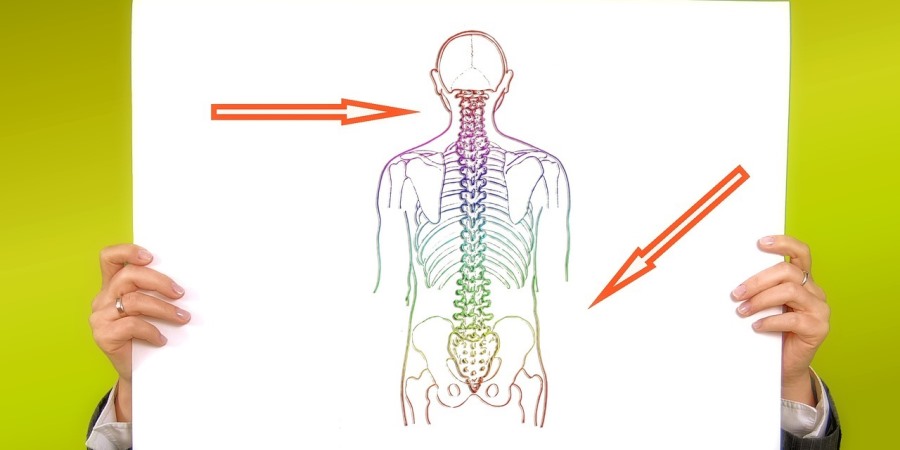
Before we continue, let’s first check on the makeup of our spine. This is helpful to better understand the remainder of this article.
The basic spine movements are forward bending (hamstring engagement), backward bending, lateral bending / side bending left and right, and twisting left and right.
The spine is usually divided up in several sections:
- Cervical vertebrae (neck region)
C1 – C7 (7 vertebrae)
Nerves to arms, breathing, head, neck. - Thoracic vertebrae (chest region)
T1 – T12 (12 vertebrae)
Nerves to the chest area and some organs in chest area. Also to the arms and some organs in abdominal area. - Lumbar vertebrae (lower back / abdominal region)
L1 – L5 (5 vertebrae)
Nerves to the legs, large intestines, sex organs, bladder. - Sacrum
5 vertebrae (fused)
Sacroiliac joint (back to pelvis connection)
Hip, pelvis, buttocks. - Coccyx
4 vertebrae (fused)
Rectum and anus. - Intricate muscles, ligaments, discs and joints
It’s this latter interweaving, interconnection of nerves with muscles, ligaments, joints, etc, that often makes it hard to exactly locate pains.
Low Back Pain
In Western countries, and as for that also increasingly in all other countries in our contemporary one-way-of-life global world, low back pain — also called lower back pain or lumbago — is perhaps the most common complaint after cold and flu.
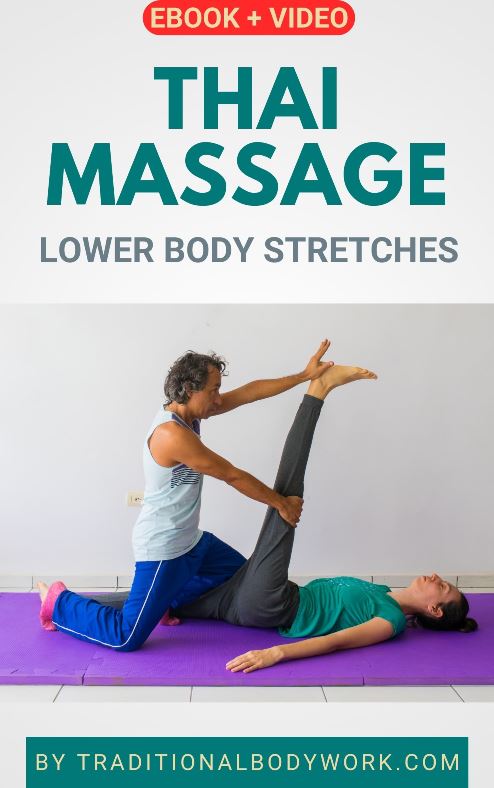
Pains may be caused by a limited or combined musculoskeletal issue or by a variety of diseases and disorders that affect or extend to the lumbar spine (lumbar = relating to the lower part of the back). Low back pain is sometimes accompanied by sciatica, which is pain that involves the sciatic nerve and is felt in the lower back, the buttocks, the backs and sides of the thighs (often only in one particular leg), and possibly also in the calves or even in the feet.
Very serious cases of low back pain may be accompanied by fever, pain that awakens a person from sleep, loss of bladder or bowel control, numbness, burning urination, swelling of the area, or sharp pains.
It’s assumed that the most common cause of low back pain is lumbar strain (what causes these strains will be discussed later). The structures of the lumbar region of the spine include the lumbar vertebrae, discs between vertebrae, the ligaments, muscles and tendons, the spinal cord within the vertebrae and the nerves going outward from the spine through vertebral openings.
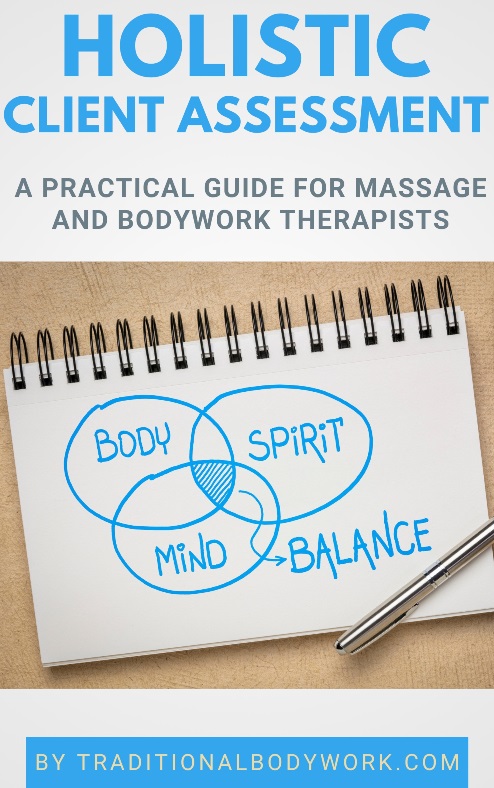
The lumbar vertebrae are different compared to the cervical (neck area) and thoracic (upper back) vertebrae, being generally thicker for greater support of weight, and resting on top of the sacrum, which is the triangular bone between the buttocks. The discs between each vertebrae absorb the shocks (while walking, running, suddenly lifting objects, etc), which else would be transmitted through the spine. Occasionally, discs may rupture or herniate outward and with that covering or putting pressure on the nerves causing pains.
Nerve pressure like sciatica (affecting the sciatic nerve) may cause low back pain. Nerve pain from other local organs may also be a cause, in which specific diagnosis and (classic) treatment is more involved, and usually the latter is a much more serious and perhaps even a life threatening condition.
Risks for low back pain are increased with fractures and osteoporosis, narrowing of the spinal canal within the vertebrae (called stenosis), spinal curvatures, fibromyalgia, osteo and rheumatoid arthritis, pregnancy, smoking, stress, increasing age, or illness of organs of the lower abdominal area.
Types of Low Back Pain
We can divide low back pain in three categories, based on duration: acute, sub-acute or chronic. In addition, lower back pain may also be categorized as:
- Local
The patient will feel soreness or discomfort when one palpates, or presses on a specific area of the lower back. - Diffuse (spread)
Diffuse pain is spread over a larger area and comes from deep tissue layers. - Radicular (root originated)
The pain is caused by irritation of a nerve root and radiates from the area. Sciatica is a good example of radicular pain. - Referred
This pain is felt in the lower back area, but is caused by an inflammation or issue elsewhere, such as the kidneys or other structures of or near the lower abdominal region, including the intestines, appendix, bladder, uterus, ovaries or the testicles.
Acute Pain
Usually, lumbar strain or sprain is the cause of acute low back pain. It’s pain that normally doesn’t go to the leg and it occurs within twenty-four hours after overuse of the back muscles. Generally, the pain is localized, and may be accompanied by muscle spasms or soreness when touched. The patient usually feels much better when taking rest.
Acute strain may be caused by a sudden movement, especially a lifting and twisting motion, however, risks of injury are increased by former overuse or lack of exercise and tone, especially of the opposing muscles (the abdominal muscles), improper use of back muscles, long periods of sitting or standing in one position, poor vertebral alignments or conditions of insufficient nutrition of the supportive structures and tissues.
Acute low back pain due to lumbar strain (approximately sixty percent of the cases) usually resolves or alleviates within a week with general conventional therapies, including reducing or eliminating all activity and taking rest.
Sub-acute Pain
Sub-acute pain develops typically over time and appears gradually (equally preceded by overuse or lack of exercise, improper use, long periods of sitting or standing in one position, etc) and symptoms usually remain during six to twelve weeks, by which time ninety percent of persons that suffer this kind of affliction return to their normal activities.
Symptoms of both acute and sub-acute low back pain may be accompanied by stiffness, constipation, deprived sleep and difficulties finding a comfortable position, difficulties walking and other limits on normal range of motion.
Chronic Pain
Low back pain longer than three months is considered chronic. Common causes are:
- Mechanical
Chronic strain on the muscles of the lower back may be caused by obesity, pregnancy, excessive job-related bending, or other stressful postures. Construction, truck driving vibrations, jack hammering, sand blasting and other sources of chronic trauma and strain to the back or pressure on nerves also contribute. But also flat feet, imbalances between left/right feet/legs, pelvic imbalance or weak pelvic floor muscles, weak abdominal and lower back muscles, and sustained contraction or tension of the piriformus, gluteus, hamstring (back thigh), quadratus lumborum and psoas muscle. - Tumors or other serious illnesses
Cancer, kidney problems, intestinal or abdominal diseases, and so on. - Ankylosing spondylitis
A form of arthritis of the spinal column. - Herniated spinal disk
Ruptured disks or bulging disks that give pressure on nerves nearby. Pains often get worse when sneezing or coughing. - Other vertebral disk problems
Degenerated, thinning bones, osteoporosis, arthritis. - Psychosomatic causes
Psycho-social issues such as unemployment, job dissatisfaction, legal or financial problems and other stress causing factors are some of the non-biological factors that may be associated or causative. In this case, low back pains are typically diffuse, not localized, and may include other stress related symptoms.
Treatments
The most common treatments of low back pain are:
- Traditional Chinese Medicine, such as acupuncture or herbal treatments;
- Yoga;
- Massage (traditional and contemporary styles of massage);
- Other Bodywork and/or exercises;
- Chiropractic;
- Herbal Medicine;
- Homeopathy;
- Osteopathy;
- Allopathic i.e. modern contemporary treatments, such as medication, surgery, physical therapy, and/or psychotherapy.
Prevention
Low back pain which is caused by muscle strain can be prevented by certain lifestyle choices, including regular physical exercise and weight control, avoiding smoking, good posture on the job and in daily life, and by learning proper techniques for lifting, carrying and moving heavy objects.
Exercises to strengthen the muscles of the lower back and the abdominal area are also of vital importance. Easy actions can also help avoiding getting low back pain, such as using a small, firm cushion behind the lower back when sitting for longer periods, using a pillow when sleeping that supports well the lower neck, using a chair with postural support or a stool that brings up the knees at a higher level than the hips, walking on flexible rubber mats to avoid the impact of concrete floors at places of employment, and wearing supportive, soft soled shoes, and avoiding wearing high heels, among other things.
Main Focus of Thai Massage Therapy
Traditional Thai Massage, being a very complete full body massage and treatment modality, and moreover, specialized in muscle and tissue stretches can help significantly in alleviating or curing back pains structurally.

In my practice I found that most of the lower back pain problems (apart from structural issues or diseases), are caused by a combination of weak back and abdominal muscles firstly, and secondly by shortened or contracted muscles of the legs (notably of the hamstrings), abdominal area, gluteus, and lower back.
These problems are often caused by sedentary, desk, chair, or couch bound lifestyles (lots of sitting, lack of movement and exercise, lack of muscle stretches) and/or emotional traumas.
So, apart from working on the acute issues, the best advice and remedy is to urge clients to really make a change in their lifestyles. The latter is perhaps the hardest part of the “treatment” and makes the life of a massage therapist difficult if a client doesn’t make any changes.
In any case, as a Thai Massage practitioner / therapist I would normally use the following methods to alleviate low back pains:

- Relaxation (stretching or nerve-triggering) the following muscles: piriformus, gluteus, hamstring (back thigh), quadriceps (front thigh), abductors, inner thigh adductors, latissimus dorsi, abdominal (rectus abdominis), erector spinae, quadratus lumborum and Ilio-psoas muscle;
- Opening and mobilization of the hip joint;
- Mobilization of the sacro-iliac joint;
- Clearing and opening the pelvic area;
- Deep Abdominal Massage to clear knots, tangles, and adhesions;
- Acupressure, general palm pressure or stretches on/of (the whole or parts of) the following energy lines:
– Sen Ittha / Pingkhala (third outside and first inside line of the upper leg, first line of the back),
– Sen Kalathari (second lines inside and outside of the upper legs, second lines of the back),
– Sen Sumana (sub-lines: third inside upper leg lines).
– Sen Sahatsarangsi / Thawari (first inside and first outside leg lines and lines three of the back). - Cracks / realignment of lumbar and thoracic vertebrae.



